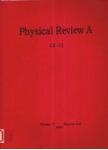版权所有:内蒙古大学图书馆 技术提供:维普资讯• 智图
内蒙古自治区呼和浩特市赛罕区大学西街235号 邮编: 010021

作者机构:Center for Quantum Information and Quantum Control Department of Electrical and Computer Engineering University of Toronto Toronto Ont. M5S 3G4 Canada
出 版 物:《Physical Review A》 (物理学评论A辑:原子、分子和光学物理学)
年 卷 期:2006年第74卷第4期
页 面:042342-042342页
核心收录:
学科分类:070207[理学-光学] 07[理学] 08[工学] 0803[工学-光学工程] 0702[理学-物理学]
主 题:UNCONDITIONAL SECURITY CRYPTOGRAPHY
摘 要:Standard security proofs of quantum-key-distribution (QKD) protocols often rely on symmetry arguments. In this paper, we prove the security of a three-state protocol that does not possess rotational symmetry. The three-state QKD protocol we consider involves three qubit states, where the first two states ∣0z⟩ and ∣1z⟩ can contribute to key generation, and the third state ∣+⟩=(∣0z⟩+∣1z⟩)∕2 is for channel estimation. This protocol has been proposed and implemented experimentally in some frequency-based QKD systems where the three states can be prepared easily. Thus, by founding on the security of this three-state protocol, we prove that these QKD schemes are, in fact, unconditionally secure against any attacks allowed by quantum mechanics. The main task in our proof is to upper bound the phase error rate of the qubits given the bit error rates observed. Unconditional security can then be proved not only for the ideal case of a single-photon source and perfect detectors, but also for the realistic case of a phase-randomized weak coherent light source and imperfect threshold detectors. Our result in the phase error rate upper bound is independent of the loss in the channel. Also, we compare the three-state protocol with the Bennett-Brassard 1984 (BB84) protocol. For the single-photon source case, our result proves that the BB84 protocol strictly tolerates a higher quantum bit error rate than the three-state protocol, while for the coherent-source case, the BB84 protocol achieves a higher key generation rate and secure distance than the three-state protocol when a decoy-state method is used.